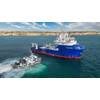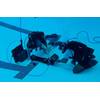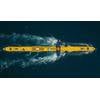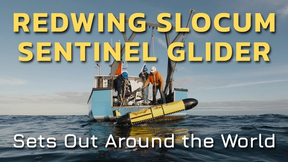Quantum Sensing Beats GPS-Denied Navigational Challenges
The same error-prone sensitivity that has slowed down the development of quantum computers is being turned into an advantage for GPS-denied navigation.
A new quantum sensing technology from Australia-based Q-CTRL has most recently caught the interest of Lockheed Martin and the US Defense Innovation Unit, but the company is already working with the Australian Department of Defence, the UK Royal Navy, the US Department of Defense and Airbus.
These agencies are interested in a quantum-sensing-based navigation system, because amidst growing international conflict, GPS denial is being increasingly used as a weapon of both traditional warfare and non-traditional economic sabotage.
“China and other state and non-state actors have been widely implicated in engaging in GPS spoofing at ports, where a fake GPS signal is used to confuse or disrupt operations. The intent can vary and has been suggested to relate to preventing the monitoring of infrastructure. This is a major concern for the commercial shipping industry, as it has occurred in many locations, including the Port of Shanghai and the South China Sea,” says Michael J. Biercuk, CEO and Founder of Q-CTRL.
Additionally, the adoption of autonomous systems and vessels is hampered by the unreliability of GPS.
Standard navigation systems rely on GPS, with mission-critical systems using the dead reckoning provided by inertial navigation systems as a back-up. However traditional inertial navigation systems using gyros and accelerometers need on-site calibration and are prone to drift over time unless they can correct from beacons in their area of operation.
Magnetic-anomaly navigation (MagNav) aims to overcome this by providing passive, non-jammable navigation through periodic position fixes obtained by comparing local measurements of Earth’s crustal field against known anomaly maps. Despite the potential, existing MagNav systems are limited by magnetometer stability and the interference caused by the magnetic characteristics of the platform they are deployed on.
Magnetic interference can be 1,000 times greater than the target magnetic anomaly magnitudes used for navigation. Existing techniques to combat this challenge can be impractical, requiring huge amounts of pre-training, calibration maneuvers during a mission and preservation of the exact same calibration conditions during the voyage.
Another challenge is the need to account for imperfections arising from adjusting anomaly maps for altitude and integrating realistic time-varying effects such as space weather and diurnal magnetic field variations.
Quantum sensing offers a solution.
Quantum technology is unstable in the presence of non-quantum environmental conditions such as magnetic fields. It takes a huge amount of effort, such as extremely low temperatures, to isolate quantum systems enough for them to be useful for computing applications.
However, quantum sensing takes advantage of that instability to detect and measure magnetic fields, gravity and acceleration with the precision exhibited by, say, quantum clocks. These clocks are so stable that they will lose just one second in 1 billion years – another feature ideally suited to GPS-denied navigation.
Where satellite navigation relies on a signal bouncing back from space, quantum navigation focuses on the response of a single atom or photon of light to “measure” external signals.
Key to success, as the company name Q-CTRL implies, is quantum control – the ability to get useful information from the quantum interactions taking place. Q-CTRL has developed novel approaches to sensor design and operation for atom interferometers, studied how error-robust light-matter interactions can improve sensor performance and learned how to exclude background interference from the signals detected by the sensors.
Q-CTRL’s quantum magnetic navigation solution, Ironstone Opal, is completely passive and undetectable and cannot be jammed or spoofed by known conventional techniques. It combines in-house-developed hardware and various software-level innovations. Key is the inclusion of a quantum magnetometer along with classical inertial navigation hardware such as a fiber-optic gyroscope. These sensors detect tiny, otherwise imperceptible signals arising from Earth’s structure that serve as magnetic “landmarks” for navigation. Only quantum sensors provide the sensitivity and stability needed to continuously “see” these landmarks from a moving vehicle.
The software includes anomaly field modelling, map levelling, upward and downward continuation and prediction of temporal effects. The navigation-and-map-matching software includes platform de-noising, statistical filters and navigation algorithms.
An iterative filter is used to calculate navigational corrections based on the de-noised magnetometer signals. It operates in real-time, enabling corrections to be provided in flight, and it learns the platform’s magnetic behavior in flight as well without the need for calibration flights.
“The Earth's crust possesses tiny variations in composition that carry unique magnetic and gravitational signatures. These appear everywhere, including under the oceans, and can be measured both underwater and at the sea surface as a map-matching-based navigational aid,” says Biercuk.
“In maritime navigation at or below the sea surface, adding gravitational detection capability provides an additional modality for map-matching-based navigation that can improve positioning accuracy. This is largely because the distance from the seafloor, interference from electrical currents in saltwater and slow vessel speeds can, in some circumstances, degrade the performance of magnetic map matching. Gravitational measurements are perfectly complementary, and a dual-mode system can provide resilience across a wide range of operating conditions.”
Q-CTRL’s MagNav system is small enough to fit on small fixed-wing drones or autonomous cars and powerful enough to enable navigation in passenger airliners. In a world-first demonstration, Q-CTRL has conducted real-world ground and airborne trials showing its quantum-assured navigation solution outperforming a high-end conventional GPS alternative by up to 50 times.
“We achieved an accuracy in some trials comparable to a sharpshooter hitting a bullseye from 1,000 yards away,” says Biercuk. “But because our quantum-assured navigation system allows a vehicle to position itself accurately irrespective of how far it’s travelled, by analogy that sharpshooter can hit the same bullseye no matter how far away they move from the target.”
Work remains to be done to validate the technology at commercial airline cruising altitudes, during highly-dynamic military maneuvers and over water where magnetic anomalies are often smaller than over land.
The availability and quality of magnetic anomaly maps must also be validated and augmented as needed. Public-domain global maps have limited resolution (2 arc minutes or approximately 3km) and are given at reference heights that limit usability (e.g. 6km). There is limited ocean coverage.
In March, Lockheed Martin and Q-CTRL were awarded a contract by the U.S. Department of Defense's Innovation Unit (DIU) to prototype a complementary quantum inertial navigation system, and Biercuk is optimistic about maritime applications: “We're excited to have already undertaken sea trials of our tight-SWaP mobile gravimeter, and we are getting ready to support Ironstone Opal Maritime for surface and subsurface vessels. Our technology is already validated to enable performance at the requisite levels in motion, and we're moving rapidly towards deployment for navigation.”















 August 2025
August 2025



